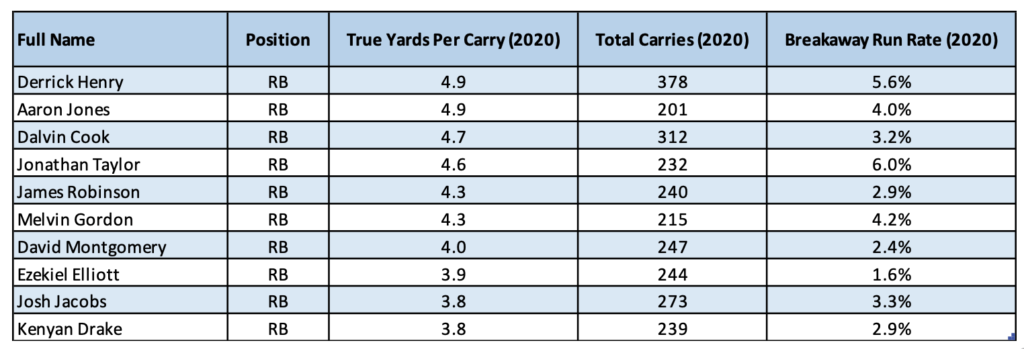Most dedicated football enthusiasts are familiar with Yards Per Carry (YPC). A simple statistic that divides total rushing yards by the total number of carries. It’s used to judge running back efficiency on the ground. Let’s look at an example.
An RB rushes for 27 yards on eight attempts. That’s a mediocre 3.4 YPC. On the next carry, said RB finds a hole and breaks off a 34-yard gain. Just like that, the YPC vaults to a jaw-dropping 6.8 mark. The defense tightens and our rusher grinds out 23 yards on the final seven handoffs. The RB’s box score line reads 16 attempts for 84 rushing yards. A respectable day on the ground and a high-end 5.3 YPC. However, remove that one long run and our trusty runner is an underwhelming plodder.
As the example shows, the picture can become skewed when we look at averages. Averages hide variation. This is one reason that Yards Per Carry has received criticism over the years in fantasy football circles. Let’s welcome to the stage, True Yards Per Carry, the focus of this edition of our Meet the Metric series.
What’s True Yards Per Carry?
True Yards Per Carry is one of the many advanced stats and metrics found on PlayerProfiler. A concept popularized by Zach Krueger in a piece written for RotoUnderworld back in 2018. True YPC adjusts the age-old YPC by discounting runs longer than 10 yards. By factoring out the disproportionate impact of long runs, the metric rewards RB consistency. Why does this matter? Running backs that are consistent provide a nice rushing floor for our fantasy teams.
Breakaway runs are exciting, but we can’t rely on them. They make up a small part of a running back’s body of work. As the numbers of carries increase, and the sample size builds, the Breakaway Run Rate naturally drops. Of the RBs that saw over 200 carries in 2020, Jonathan Taylor (why are we not surprised), led the way with a 6.0-percent (No. 9 among qualified running backs) Breakaway Run Rate. The average for this group was 3.6-percent. This is the value that True YPC brings. It tells us how efficient an RB is on 90-percent plus of carries.
Who Were The True YPC Leaders In 2020?
This may seem obvious, but when reviewing True Yards Per Carry, please reference the workload. If not, the 2020 leaders are T.J. Yeldon at 6.2 (10 total carries) and Marlon Mack at 6.1 (four total carries). With that said, let’s focus on RBs with actual rushing volume. In 2020, only 10 RBs surpassed 200 carries. With injury robbing playing time from the likes of Christian McCaffrey, Saquon Barkley, Joe Mixon, and Nick Chubb, it is reasonable that the list is shorter. It’s still a big decrease from the 20 RBs with 200-plus carries in 2019.
Derrick Henry and Aaron Jones led the way with 4.9 True YPC averages. With a whopping 378 carries, King Henry nearly doubled Jones in attempts and still managed the same stellar average. In fact, Henry posted the highest True YPC for any RB seeing over 200 carries in the last three seasons. Rounding out the top performers are Dalvin Cook and Jonathan Taylor. On the flip side, Ezekiel Elliott, Josh Jacobs and Kenyan Drake were generally inefficient last year. Despite performing at below average levels, rushing volume keeps them on the list.
Honorable mention goes to Nick Chubb, Alvin Kamara and Ronald Jones. This trio fell short of the arbitrary 200 carry cut-off, but posted high marks. Kamara and Jones both had 4.7 True YPC averages. Chubb’s elite 5.1 True YPC output would have topped the table. Kamara ended the season as the RB1 in Fantasy Points Per Game due to a 22.3-percent (No. 1) Target Share on top of his 187 (No. 15) carries.
Which RBs Can Join The List in 2021?
Expanding the sample to include RBs with 100-plus carries provides 47 names for 2020. The average True YPC was 4.2 yards. Christian McCaffrey and Nick Chubb are obvious candidates to rejoin the list in 2021. Both had over 250 carries in 2019 and averaged 4.4 and 4.6 TYPC, respectively. They’ve done it, so let’s turn our attention to a couple of ascending rushers.
J.K. Dobbins is special pic.twitter.com/uTXrJ7Qzka
— Ray G ? (@RayGQue) May 13, 2021
In his rookie campaign, J.K. Dobbins logged 134 (No. 33) carries for 805 (No. 16) rushing yards, leading the league with a dazzling 5.4 True YPC average. Boosted by a No. 1-ranked 8.2-percent Breakaway Run Rate, his True YPC should be expected to dip as he earns more work. However, this elite average gives him plenty of room to stay in the upper echelon. He produced an impressive 2.18 (No. 3) Yards Created Per Touch with a 30.9-percent (No. 5) Juke Rate. Efficiency on the ground is part of Dobbins’ repertoire, but usage through the air is still lacking.
https://www.youtube.com/watch?v=o9a8hrqcD64
Antonio Gibson was 2020’s third-most productive rookie RB in fantasy. He had 170 (No. 18) carries for 795 (No. 18) rushing yards and averaged 14.4 (No. 17) Fantasy Points Per Game. Gibson was elusive with 58 (No. 13) Evaded Tackles and a 28.2-percent (No. 8) Juke Rate. He had a low 76.8 (No. 39) Run Blocking Efficiency rating, yet still managed a 4.5 (No. 18) True YPC average. Luckily, Washington has committed to strengthening the offensive line this offseason.






